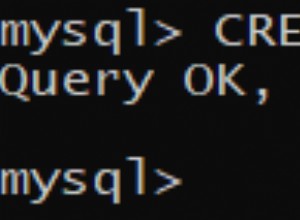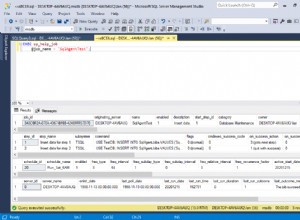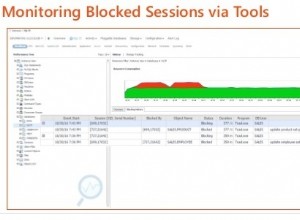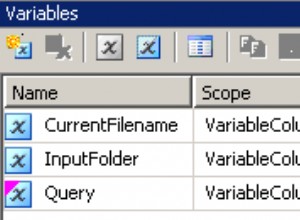Modelowanie kotwic to dobry sposób na zaimplementowanie czasowego dB — zobacz artykuł w Wikipedii też.Przyzwyczajenie się zajmuje trochę czasu, ale działa dobrze.Istnieje narzędzie do modelowania online i jeśli załadujesz dostarczony plik XML [File -> Load Model from Local File] powinieneś zobaczyć coś takiego - użyj także [Layout --> Togle Names] .
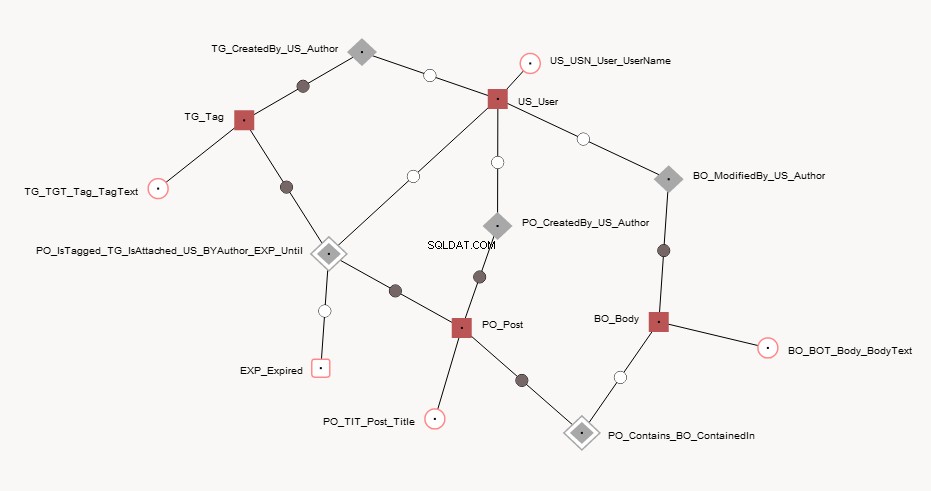
[Generate --> SQL Code] wygeneruje DDL dla tabel, widoków i funkcji punktu w czasie. Kod jest dość długi, więc nie zamieszczam go tutaj. Sprawdź kod — może być konieczne zmodyfikowanie go dla swojej bazy danych.
Oto plik do załadowania do narzędzia do modelowania.
<schema>
<knot mnemonic="EXP" descriptor="Expired" identity="smallint" dataRange="char(1)">
<identity generator="true"/>
<layout x="713.96" y="511.22" fixed="true"/>
</knot>
<anchor mnemonic="US" descriptor="User" identity="int">
<identity generator="true"/>
<attribute mnemonic="USN" descriptor="UserName" dataRange="varchar(32)">
<layout x="923.38" y="206.54" fixed="true"/>
</attribute>
<layout x="891.00" y="242.00" fixed="true"/>
</anchor>
<anchor mnemonic="PO" descriptor="Post" identity="int">
<identity generator="true"/>
<attribute mnemonic="TIT" descriptor="Title" dataRange="varchar(2)">
<layout x="828.00" y="562.00" fixed="true"/>
</attribute>
<layout x="855.00" y="471.00" fixed="true"/>
</anchor>
<anchor mnemonic="TG" descriptor="Tag" identity="int">
<identity generator="true"/>
<attribute mnemonic="TGT" descriptor="TagText" dataRange="varchar(32)">
<layout x="551.26" y="331.69" fixed="true"/>
</attribute>
<layout x="637.29" y="263.43" fixed="true"/>
</anchor>
<anchor mnemonic="BO" descriptor="Body" identity="int">
<identity generator="true"/>
<attribute mnemonic="BOT" descriptor="BodyText" dataRange="varchar(max)">
<layout x="1161.00" y="491.00" fixed="true"/>
</attribute>
<layout x="1052.00" y="465.00" fixed="true"/>
</anchor>
<tie timeRange="datetime">
<anchorRole role="IsTagged" type="PO" identifier="true"/>
<anchorRole role="IsAttached" type="TG" identifier="true"/>
<anchorRole role="BYAuthor" type="US" identifier="false"/>
<knotRole role="Until" type="EXP" identifier="false"/>
<layout x="722.00" y="397.00" fixed="true"/>
</tie>
<tie timeRange="datetime">
<anchorRole role="Contains" type="PO" identifier="true"/>
<anchorRole role="ContainedIn" type="BO" identifier="false"/>
<layout x="975.00" y="576.00" fixed="true"/>
</tie>
<tie>
<anchorRole role="CreatedBy" type="TG" identifier="true"/>
<anchorRole role="Author" type="US" identifier="false"/>
<layout x="755.10" y="195.17" fixed="true"/>
</tie>
<tie>
<anchorRole role="CreatedBy" type="PO" identifier="true"/>
<anchorRole role="Author" type="US" identifier="false"/>
<layout x="890.69" y="369.09" fixed="true"/>
</tie>
<tie>
<anchorRole role="ModifiedBy" type="BO" identifier="true"/>
<anchorRole role="Author" type="US" identifier="false"/>
<layout x="1061.81" y="322.34" fixed="true"/>
</tie>
</schema>

